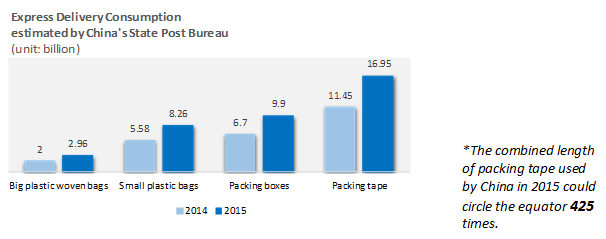China spearheads the global e-commerce boom, with online retail sales reaching 5.16 trillion yuan (US$752 billion) in 2016, a year-on-year increase of 26.2 per cent. According to China’s State Post Bureau, more than 31 billion parcels were delivered in 2016, which is equivalent to 23 parcels per capita.
For each parcel, retailers and delivery companies may use up to seven types of packaging material including paper waybills, envelopes, cartons, plastic bags, woven bags, tape and buffer materials like bubble wrap. Very often, excessive packaging is used to protect goods and reduce the risk of damage during transport.

This colossal demand for online deliveries has inevitably resulted in a corresponding increase in packaging material consumption. Whilst both paper and plastic can be recycled, less than 10 per cent of the paper and plastic packaging material ends up being recycled, and overall, less than 20 per cent all packaging materials in China are recycled.
Once it has served its purpose, most of this packaging goes straight to landfills where it creates a burden on China’s environment. Many of the materials are not biodegradable, and some may even contain harmful chemicals such as plasticizers and fire retardants that could present risks to human health.
To meet the rising demand in e-commerce, businesses must work with multiple stakeholders to come up sustainable solutions to this packaging problem:
- The Government
Currently, the environmental impacts and recycling of e-commerce packaging are not regulated by the Chinese Government. The State Post Bureau actively promotes green packaging in the delivery industry, and aims to “build a recycling system and eliminate all harmful materials from packaging by 2020”, but the lack of relevant legislation, regulation or strong policies is still one of the major barriers to tackling the mounting packaging waste. The cost of packaging to the environment and human health has yet to be factored in the market pricing mechanisms, which means that companies do not have financial incentives to choose more sustainable options.
- Retailers and Delivery Companies
To meet the booming market demand while maintaining the quality of delivery and price competitiveness, a significant number of retailers and delivery companies choose to use much cheaper, non-degradable plastic bags like those made from chemical industry waste that contain harmful materials. Meanwhile, attempts to recycle the packaging waste from consumers or the end-users can add to the costs of delivery due to the rather immature recycling industry in China. The lack of strong financial incentives prevents companies from evolving towards greener choices of packaging materials and the adoption of more efficient practices of packaging and delivery.
Chinese delivery companies, for example, can learn from United Parcel Service (UPS), one of the world’s largest package delivery companies, and see how they offer various sustainable solutions to packaging. UPS introduced the industry’s first Reusable Express Envelope in 1998, and the current envelop is made from 100 per cent recycled fibre with 80 per cent post-consumer waste. UPS is also committed to carbon neutral shipment (see their solutions here). Moreover, UPS helps companies to evaluate their packaging processes through the eco-responsible packaging program, where companies can gain verification and recognition in sustainable packaging.
Collaboration and innovation can further help China think out of the box. Cainiao Network, a logistics alliance launched by Chinese e-commerce giant Alibaba Group, has been taking the lead in the industry to drive change:
- Go Green Project
In 2013, Cainiao Network launched this green logistics initiative with 32 Chinese and international partners, focusing on green solutions such as promoting the use of greener packaging and recycling, adopting electric delivery vehicles in nearly 20 cities, and applying big data to improve efficiency in logistics. In 2015, the project saved 1 billion packing boxes and delivered 0.5 million parcels packed in 100 per cent bio-degradable materials to consumers. Continuing to optimise resources and minimise energy usage, the project aims to reduce 3.62 million tonnes of carbon emissions from the industry by 2020.
The cost of packaging to the environment and human health has yet to be factored in the market pricing mechanisms, which means that companies do not have financial incentives to choose more sustainable options.
- Cainiao Green Alliance Foundation
In 2016, Cainiao Network, Alibaba Foundation, China Environmental Protection Foundation, and the six largest logistics companies in China established the Foundation. An investment of 300 million Yuan has been planned for research use to promote green logistics, consumption and supply chain management.
The delivery sector in China needs to do more to catch up with the global industry leaders in terms of sustainability while the e-commerce sector should gradually transition towards a greener ecosystem. Beyond governmental and industrial efforts to turn challenges of packaging waste into future sustainable business opportunities, every one of us, as a consumer, should act now and act together to ensure our increasingly convenient and fast online shopping experience does not end up costing us the Earth.
Gloria Luo is Project Coordinator at CSR Asia. This article is republished from the CSR Asia blog.

